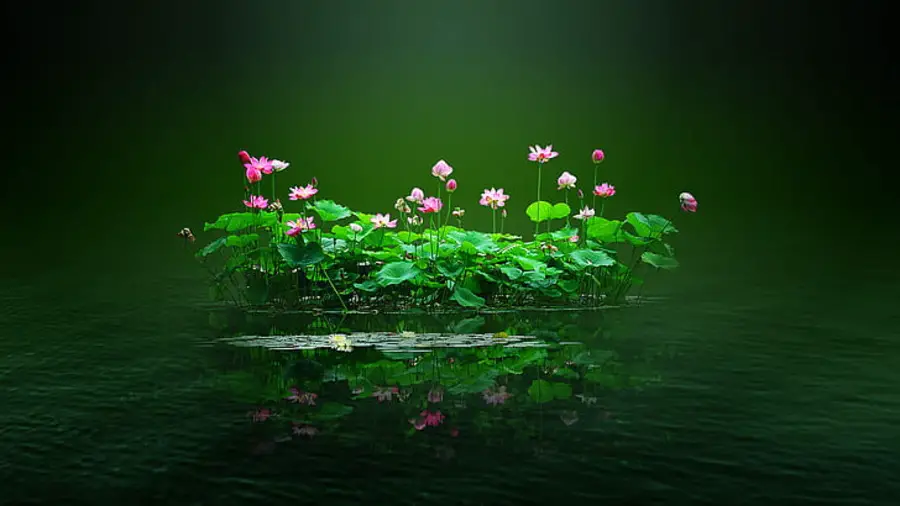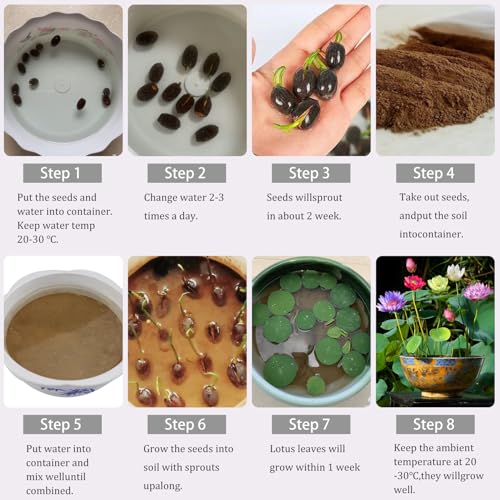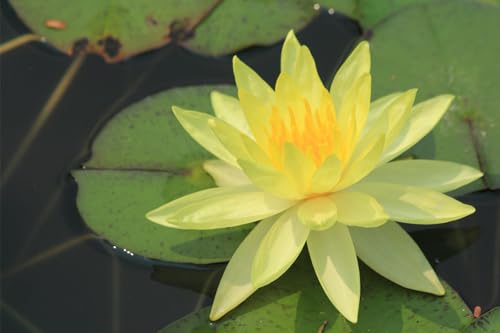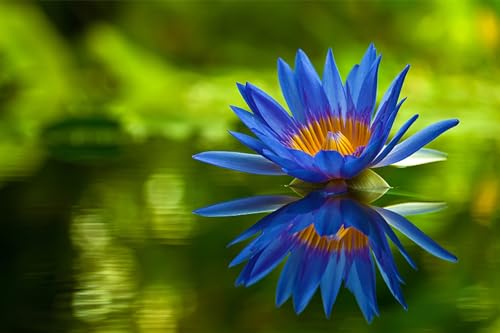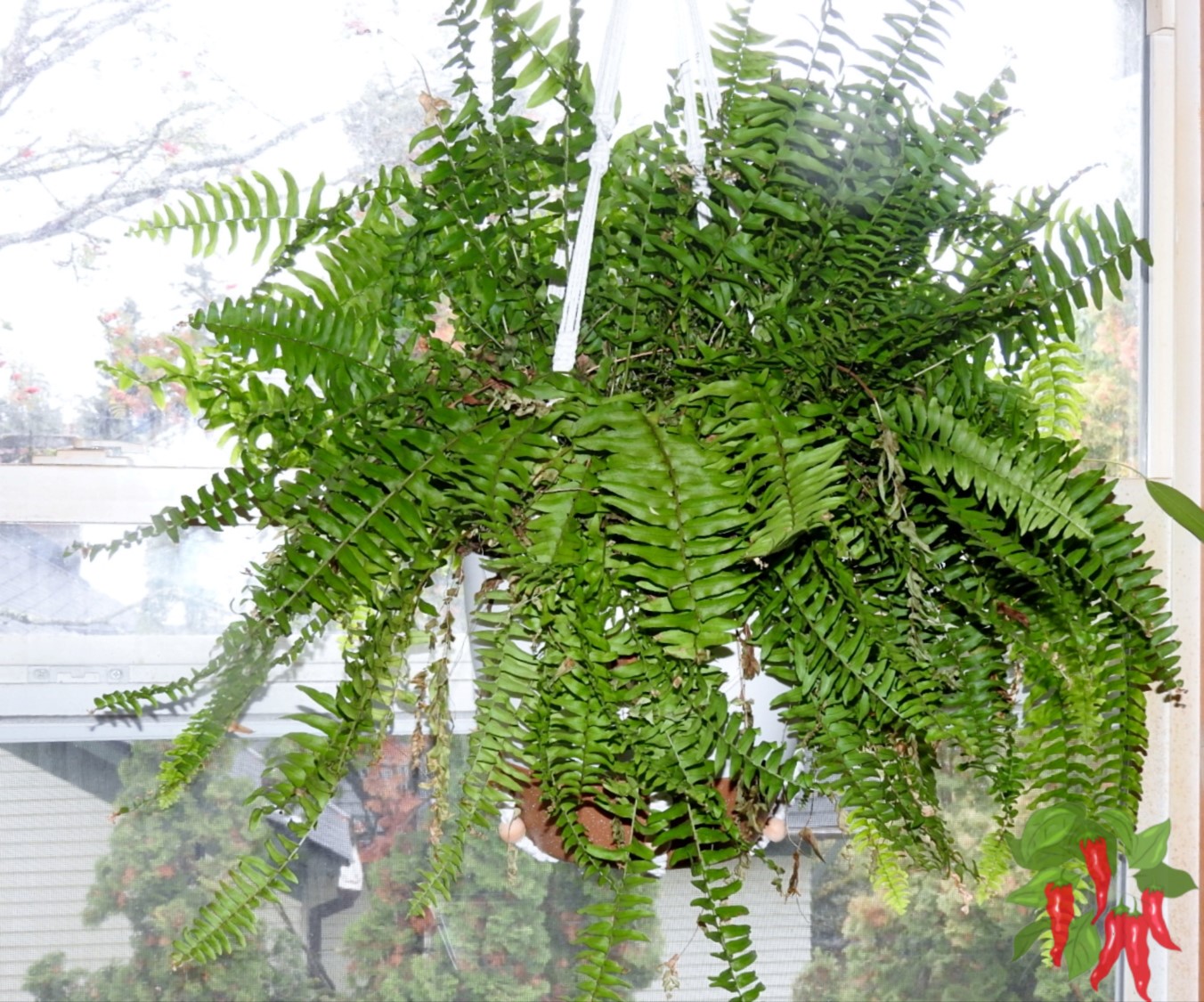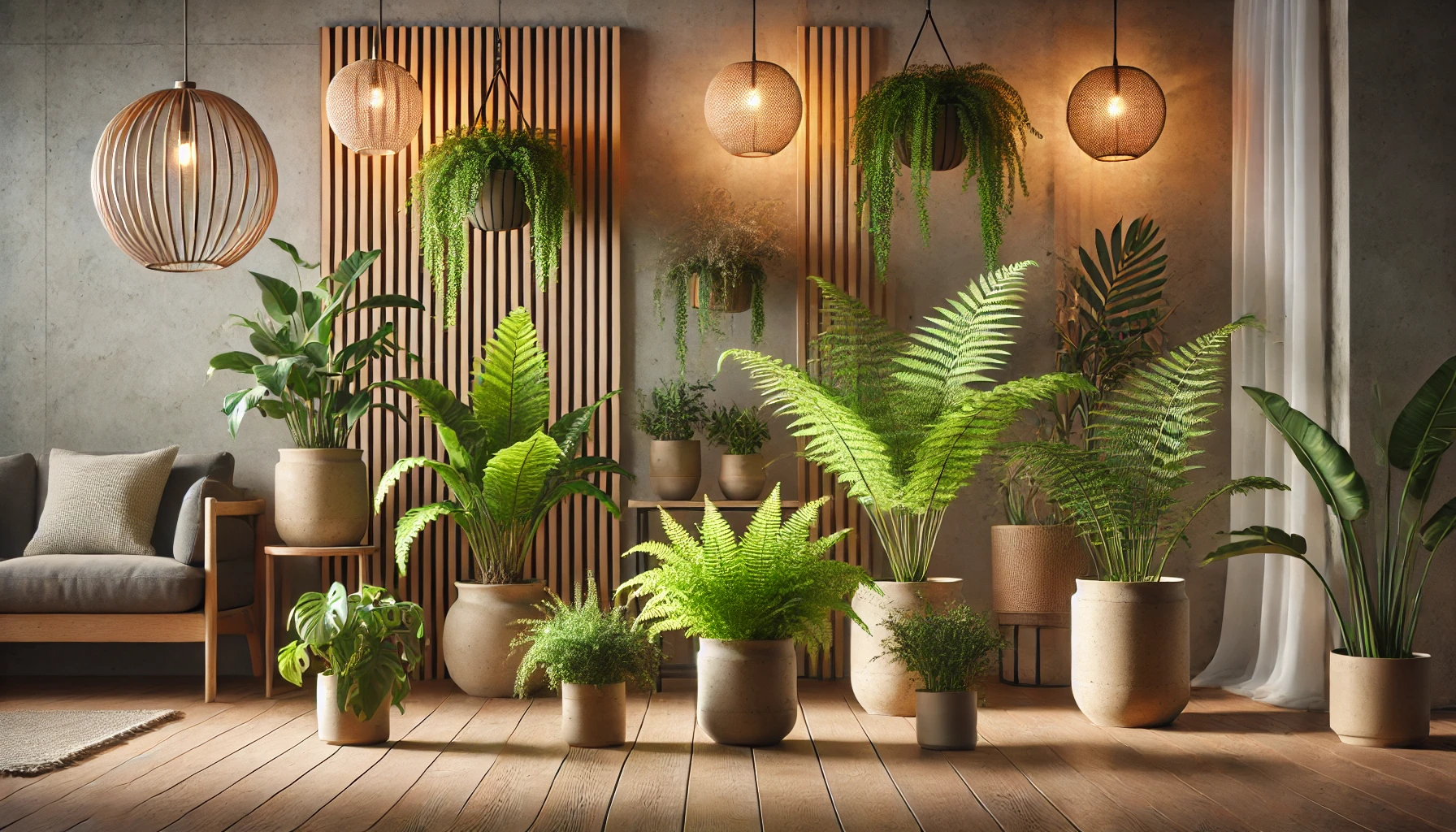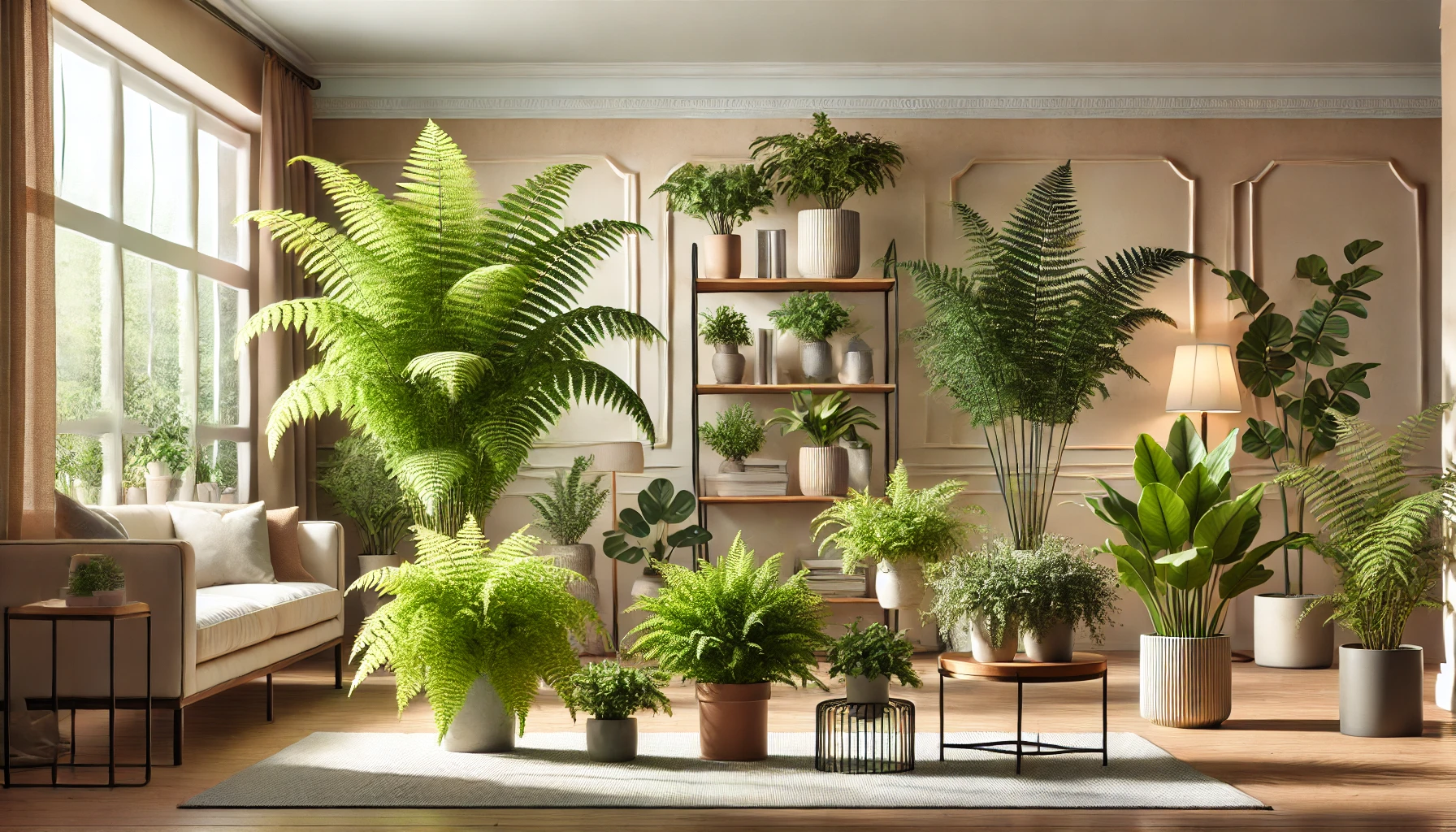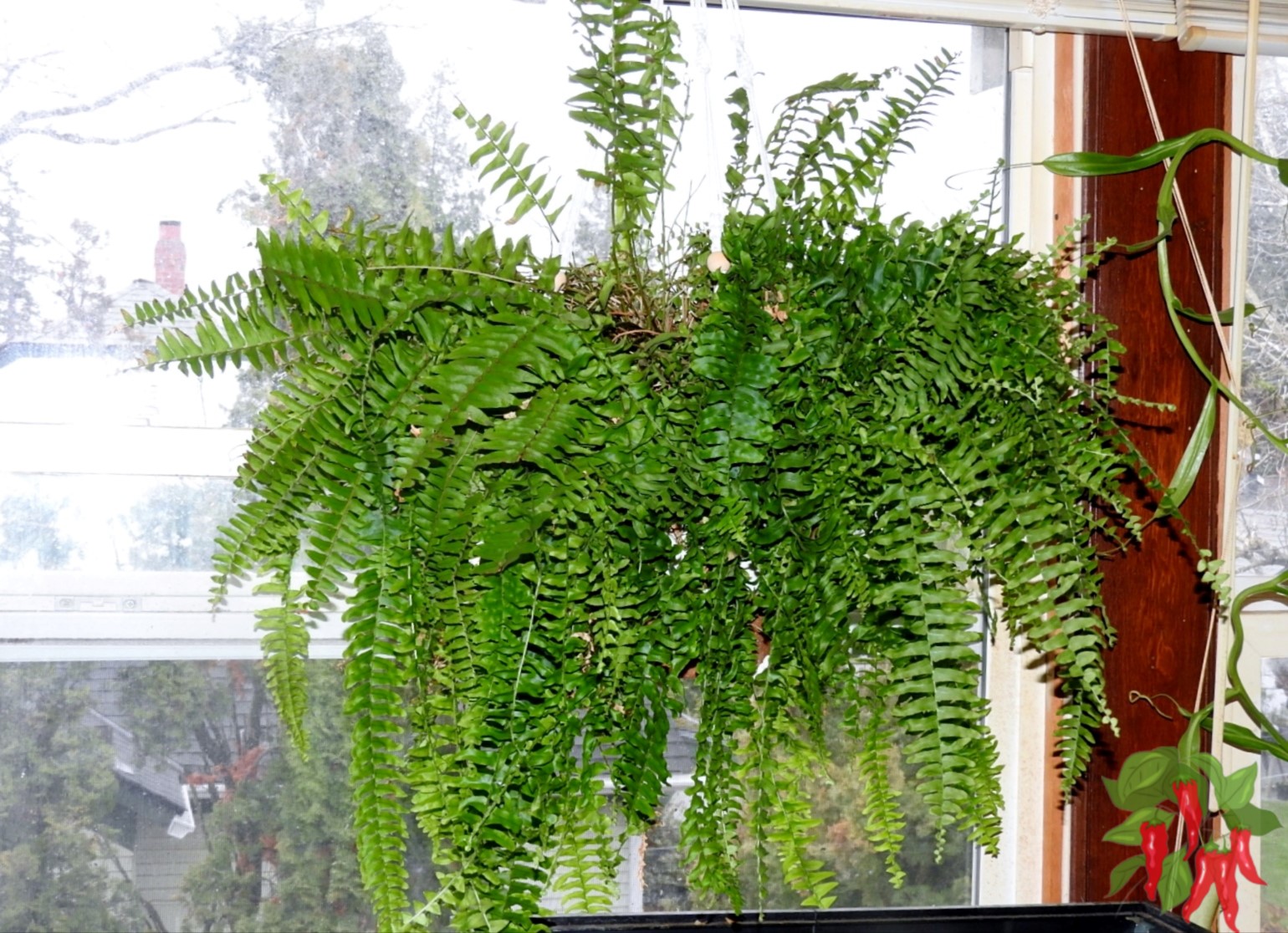This post contains affiliate links. If you buy something from one of our links we may earn a commission. Thanks

Discover the beauty of Growing Lotus Indoors! Learn how to care for lotus plants, enhance your space with Feng Shui, and create a calming sanctuary at home.
Growing Lotus Indoors is an exciting way to bring elegance and tranquility into your home.
Growing Lotus Indoors Key Takeaways
- Growing Lotus Indoors involves planting in a wide, shallow container with heavy soil and maintaining 6+ hours of sunlight daily.
- Keep water levels consistent, and fertilize monthly during the growing season.
- Place lotus in meditation spaces or entryways to align with Feng Shui principles and enhance your home’s harmony and beauty.
Growing Lotus Indoors: Growth Tips & Feng Shui

10pcs Mixed Pink, Red & Green Color Bowl Lotus Seeds for Planting Beautiful Water Plants for Indoor Bonsai, Outdoor Ponds and Gardens Water Lily Seeds
These stunning plants are more than just beautiful—they symbolize purity and spiritual growth in Feng Shui.
With the right care and placement, lotus flowers can thrive indoors, filling your space with serene energy and vibrant blooms.
Overview of Growing Lotus Indoors
Growing lotus indoors is a wonderful way to combine natural beauty with meaningful energy in your home.
These elegant flowers are visually stunning and hold deep significance in Feng Shui, symbolizing purity, enlightenment, and spiritual growth.
Blending Practical Care with Spiritual Benefits
By blending practical care techniques with spiritual benefits through intentional placement, you can create a harmonious, serene environment that nurtures your space and spirit.
Part 1: Understanding the Lotus in Feng Shui
The lotus is more than just a beautiful flower, it’s a powerful symbol in Feng Shui. Representing purity, enlightenment, and resilience, the lotus inspires a sense of peace and balance.
Understanding its significance can help you incorporate it into your home in a way that promotes harmony and spiritual growth.
The lotus flower holds deep symbolic meaning in Feng Shui, representing purity, enlightenment, and spiritual growth.
Its ability to thrive in muddy waters yet bloom beautifully signifies resilience and the ability to rise above challenges.
By incorporating the lotus into your home, you can invite clarity, peace, and a sense of renewal into your space.
- Purity: The lotus embodies cleanliness and peace, symbolizing a fresh start and a clear mind.
- Enlightenment: Its upward growth reflects spiritual awakening and personal growth.
- Resilience: The lotus thrives in adversity, serving as a reminder of strength and perseverance.
Using lotus plants in Feng Shui brings these qualities to life, creating a serene and uplifting environment.
Lotus as a Symbol in Water Features
Incorporating lotus plants into water features is a beautiful way to enhance their symbolic and aesthetic value.
The lotus pairs perfectly with the calming flow of water, creating a sense of balance and tranquility.
Here are some key benefits of combining lotus with water features:
Benefits of Lotus in Water Features
- Symbol of Harmony: The lotus complements the calming effect of water, promoting peace and balance.
- Energy Flow: Flowing water paired with a blooming lotus enhances the smooth flow of positive energy in your home.
- Decorative Appeal: Lotus flowers add elegance to any water feature, creating a visually stunning focal point.
Integrating Lotus for Energy and Balance
Integrating lotus into water features amplifies aesthetics and strengthens spiritual energy in your space.
Part 2: Setting Up Your Indoor Lotus
Setting up your indoor lotus is the first step toward enjoying its beauty and benefits.
From choosing the right container to preparing the soil and water, each detail plays a role in helping your lotus thrive.
With the right setup, you create a serene and flourishing environment for this remarkable plant.
How to Grow a Lotus Flower in a Bowl
Growing lotus flowers in a bowl is a creative and space-saving way to bring their beauty into your home.
This method is perfect for small spaces and allows you to enjoy their elegance up close. Follow these steps to set up your lotus in a bowl:
A Simple Way to Grow Lotus Indoors – Step-by-Step Guide
- Choose the Right Bowl: Select a wide, shallow bowl at least 6 inches deep without drainage holes.
- Prepare the Soil: Use heavy, loamy soil rich in nutrients. Avoid light potting mixes that may float.
- Plant the Tuber: Place the lotus tuber horizontally on the soil surface, ensuring the growth tips are above the soil.
- Add Water: Fill the bowl with water until it covers the soil by about 2 inches. Keep the water level consistent.
- Provide Sunlight: Place the bowl in a sunny spot with at least 6 hours of direct light daily.
With this simple setup, your lotus will thrive, transforming even the smallest corner of your home into a serene retreat.
Lotus Plant Care Reference Guide
| Characteristic | Details |
|---|---|
| Common Name | Lotus |
| Botanical Name | Nelumbo nucifera |
| Native Habitat | Tropical Asia and Australia |
| Plant Type | Aquatic Perennial |
| Growth Pattern | Horizontal Spread with Floating Leaves |
| Mature Size | 1-5 feet tall, 3-6 feet wide |
| Watering | Maintain 2-3 inches of water above soil |
| Light/Sun Exposure | Full Sun (6-8 hours daily) |
| Soil Type | Heavy Loamy Soil |
| Soil pH | Neutral to Slightly Acidic (6.5-7.5) |
| Temperature | 75-85°F (24-29°C) |
| Humidity | High Humidity Preferred |
| Bloom Time & Flower Color | Summer; Pink, White, Yellow |
| Potential Problems | Pests (aphids, spider mites), yellowing leaves |
| Repotting | Every 2-3 years |
| Hardiness Zones (USDA) | 4-10 (in ponds) or Indoors |
Choosing the Right Lotus Variety
Finding the Perfect Lotus for Indoors
Not all lotus plants are suited for indoor environments, but selecting the right variety ensures a thriving and manageable addition to your home.
Dwarf and miniature lotus varieties are ideal for indoor spaces, offering vibrant beauty without requiring too much room.
Best Indoor Lotus Varieties
- Dwarf Lotus: Compact and easy to manage, these varieties thrive in small containers and bowls.
- Miniature Lotus: Known for their delicate blooms, miniature lotus varieties bring elegance to any space.
- Hybrid Varieties: Many hybrids are designed for indoor growing, offering hardier plants with vibrant colors.
By choosing the right lotus variety, you enjoy their beauty while making care and placement much easier in your home.
Part 3: How to Grow Lotus from Seeds

Jardinpatio 160pcs Bowl Lotus Seeds Mixed Lotus Seeds for Planting Water Features Bonsai Lotus Flower Seeds Indoor Outdoor Garden Pond Grow Easily Low Maintenance
Growing lotus from seeds is a fascinating and fulfilling experience, allowing you to witness the entire life cycle of this iconic plant.
From a seed to its stunning blooms, the process is rewarding and educational.
With some patience and proper care, you can nurture a vibrant lotus plant right from the start.
Start Your Lotus Journey from the Beginning
Growing lotus from seeds is a rewarding way to cultivate these stunning plants while experiencing their full life cycle.
You can nurture a lotus plant from a small seed to a flourishing beauty. Here’s how to get started:
Step-by-Step Guide to Growing Lotus from Seeds
- Prepare the Seeds:
- Inspect the seeds and look for the pointed end.
- Scarify the seed by lightly sanding the pointed tip with a file or sandpaper until the inner layer is visible. This step helps the seed absorb water and sprout.
- Soak the Seeds:
- Place the scarified seeds in a bowl of warm water.
- Change the water daily, keeping it warm, to prevent bacteria and mold growth.
- Within 4-7 days, you should see the seeds start to sprout.
- Plant the Sprouted Seeds:
- Once the sprouts are 4-6 inches long, transfer them to a container with heavy loamy soil.
- Place the sprouted seed gently on the soil surface, covering it lightly to keep it stable.
- Add Water:
- Fill the container with water until it covers the soil by about 2 inches.
- Maintain consistent water levels throughout the growing process.
- Provide Sunlight:
- Position the container in a location with 6-8 hours of direct sunlight daily.
- Ensure the temperature stays warm, ideally between 75-85°F (24-29°C).
- Fertilize:
- Once the seedling has a few floating leaves, begin fertilizing with a slow-release aquatic fertilizer.
Tips for Success
- Be patient, as lotus plants may take several months to bloom.
- Avoid disturbing the roots once the seedling is planted.
- Monitor for pests like aphids, and address issues promptly.
Growing lotus from seeds allows you to enjoy the entire journey of this remarkable plant, from its humble beginnings to its majestic blooms.
Caring for Lotus Indoors
Essentials for Thriving Indoor Lotus Plants
Proper care is essential to keeping your lotus healthy and blooming indoors. By focusing on their specific light, water, and temperature needs, you can create an ideal environment for these stunning plants to thrive.
Lighting Needs
- Direct Sunlight: Lotus requires at least 6-8 hours of direct sunlight daily. Place them near a sunny window or under grow lights if needed.
- Avoid Shade: Insufficient light can hinder blooming and weaken the plant.
Watering Tips
- Consistent Water Levels: Maintain water levels about 2-3 inches above the soil in the container.
- Clean Water: Use filtered or dechlorinated water to prevent buildup of harmful chemicals.
Temperature Requirements
- Warm Environment: Lotus thrives in temperatures between 75-85°F (24-29°C).
- Avoid Cold: Keep the plant away from drafts or air conditioning vents to prevent stress.
With the right lighting, watering, and temperature, your indoor lotus will flourish, adding beauty and serenity to your home.
Propagating Lotus Plants for Renewal
Growing More Beauty and Serenity
Propagating lotus plants is a rewarding way to expand their calming presence in your home.
Whether you want to create new plants for yourself or share them with others, propagation is a straightforward process that encourages renewal and growth.
Techniques for Propagating Lotus Plants
- Tuber Division:
- Gently remove the lotus tuber from its container.
- Use a clean knife to divide the tuber, ensuring each section has at least one growth node.
- Plant the divided tubers in fresh soil and water as you would with a new lotus.
- Seed Germination:
- Scarify the seed by lightly sanding its outer coating to encourage sprouting.
- Place the seed in warm water and change the water daily until it sprouts.
- Once sprouted, transfer the seedlings to a container with soil and water.
By propagating lotus plants, you can create more opportunities for beauty, calm, and positive energy in your home or share the joy of lotus with friends and family.
Seasonal Care for Lotus Plants
Keeping Your Lotus Vibrant Through the Seasons
Lotus plants have different needs depending on the time of year. Adjusting your care routine for each season ensures healthy growth and vibrant blooms year-round.
Here’s how to adapt your care:
Spring and Summer (Growing Season)
- Increased Sunlight: Provide 6-8 hours of direct sunlight daily to support blooming.
- Regular Fertilization: Apply a balanced, slow-release aquatic fertilizer monthly.
- Water Levels: Keep water levels consistent, ensuring the soil stays submerged.
Fall (Transition Period)
- Reduced Fertilizer: Gradually decrease fertilization as growth slows.
- Prune Dead Leaves: Remove any yellowing or dying foliage to maintain plant health.
Winter (Dormant Season)
- Minimal Care: Stop fertilization and reduce watering; keep the plant in a cool, frost-free area.
- Light Maintenance: Ensure the plant still receives some indirect sunlight.
By tailoring your care routine to each season, your lotus will thrive and reward you with vibrant, lasting blooms.
Part 4: Feng Shui Placement for Indoor Lotus
Placing a lotus plant in the right spot isn’t just about aesthetics. It’s about enhancing the flow of energy in your home.
The lotus symbolizes purity and spiritual growth in Feng Shui. Thoughtful placement can amplify its positive impact.
Let’s explore how to position your indoor lotus for maximum harmony and balance.
Best Placement for Lotus Indoors
Finding the Perfect Spot for Positive Energy
Where you place your lotus indoors can significantly influence the energy it brings to your space.
Thoughtful positioning enhances the calming and spiritual benefits that this beautiful plant symbolizes.
Tips for Ideal Placement
- Meditation Areas: Place lotus in meditation spaces to encourage peace and deeper focus.
- Living Rooms: Position near a sunny window in the east or southeast to promote harmony and renewal.
- Entryways: Use lotus near entrances to welcome positive energy and a sense of calm into your home.
The right placement ensures your lotus thrives and fosters a serene and balanced atmosphere.
Lotus in Meditation Spaces
Enhancing Tranquility with Lotus
A lotus plant can be a powerful addition to your meditation space, symbolizing purity and spiritual awakening.
Its serene energy creates an environment that promotes focus, mindfulness, and inner peace.
Tips for Using Lotus in Meditation Areas
- Centerpiece Placement: Place the lotus as a focal point to draw attention and encourage calm.
- Natural Light: Position the plant where it receives bright, indirect sunlight to keep it healthy and vibrant.
- Water Features: Combine the lotus with a small fountain or bowl to amplify the soothing effects of flowing water.
Incorporating lotus into your meditation space fosters a serene atmosphere, helping you connect with your inner self during your practice.
Lotus in the Spiritual Corner
Fostering Growth and Harmony
In Feng Shui, the spiritual corner of your home is associated with personal growth, enlightenment, and balance.
Placing a lotus plant in this area enhances these energies, creating a space that promotes peace and introspection.
Tips for Placing Lotus in the Spiritual Corner
- Locate the Spiritual Area: Typically found in the northeast corner of your home, as per Feng Shui principles.
- Use a Dedicated Spot: Set up the lotus in a quiet, uncluttered area to allow its calming energy to flow freely.
- Combine with Symbols: Pair the lotus with other spiritual elements like candles, crystals, or sacred objects to amplify its impact.
A lotus in the spiritual corner encourages reflection, balance, and a deeper connection to your personal journey.
Lotus in Entryways
Inviting Calm and Positive Energy
Placing a lotus near the entryway of your home is a powerful way to welcome purity and tranquility.
In Feng Shui, this placement helps set the tone for a harmonious and serene living space, greeting everyone who enters with positive energy.
Tips for Using Lotus in Entryways
- Position Strategically: Place the lotus near the door, ensuring it receives adequate light for healthy growth.
- Choose a Decorative Pot: Use a stylish container to enhance the plant’s visual appeal and create a welcoming atmosphere.
- Pair with Other Elements: Combine with water features, stones, or soft lighting to amplify the calming effect.
A lotus in your entryway serves as a beautiful symbol of peace, inviting balance and serenity into your home.
Part 5: Enhancing Your Space with Lotus
Lotus plants are more than just symbols of purity as they’re also stunning additions to your decor.
Whether working with a small apartment or a larger home, incorporating lotus plants can elevate your space with elegance and balance.
Let’s explore creative ways to use lotus to enhance your indoor environment.
Decorating with Lotus Indoors

60 Pcs Mix Bonsai Bowl Lotus Seeds, Water Lilys Flower Plant, Lotus Seeds for Planting Water Features Seeds Non-GMO Fresh Garden Seeds
Style Meets Serenity
Lotus plants bring a unique combination of beauty and tranquility to your living spaces.
Their graceful blooms and symbolic meaning make them a perfect choice for promoting balance and purity in your home decor.
Creative Ways to Style Lotus Indoors
- Statement Pieces: Use a lotus in a decorative bowl or container as a centerpiece for your living room or dining table.
- Corner Accents: Place lotus in underutilized corners to add life and energy to the space.
- Pair with Water Features: Combine lotus with fountains or decorative water bowls for a serene and elegant touch.
- Shelf Displays: Use miniature lotus varieties to decorate shelves or windowsills, bringing nature into smaller areas.
By intentionally styling lotus plants, you can enhance your home’s aesthetic while fostering a calm and harmonious atmosphere.
Lotus for Small Spaces
Big Beauty in Small Spaces
Even in compact living areas like apartments, you can enjoy the elegance of lotus plants.
With the right variety and thoughtful placement, the lotus can thrive and enhance smaller spaces without overwhelming them.
Tips for Growing Lotus in Small Spaces
- Choose Miniature Varieties: Opt for dwarf or miniature lotus plants that are perfectly suited for small containers.
- Use Space-Saving Containers: Select decorative bowls or pots that fit neatly on shelves, windowsills, or countertops.
- Maximize Light: Place the lotus in a sunny spot where it can receive 6-8 hours of light daily, such as near a south-facing window.
- Pair with Simple Decor: Avoid overcrowding the area by keeping the surrounding decor minimal to let the lotus shine.
With these adjustments, you can create a serene and beautiful setup that fits seamlessly into small living spaces.
Combining Lotus with Other Water Plants
Creating a Harmonious Aquatic Display
Pairing lotus with other aquatic plants not only enhances their visual appeal but also strengthens the positive Feng Shui energy they bring to your space.
Together, they create a balanced and vibrant indoor water garden.
Best Aquatic Plant Combinations
- Water Lilies: Complement the lotus with their broad, flat leaves and colorful blooms for a stunning contrast.
- Duckweed: Add texture and a touch of greenery to the water surface, creating depth and harmony.
- Papyrus: Use taller aquatic plants to provide vertical interest and balance to the lotus’s horizontal spread.
- Aquatic Ferns: Incorporate small, delicate ferns to soften the overall look and bring variety.
By thoughtfully combining lotus with other water plants, you can create an indoor display that radiates beauty and balanced energy.
Part 6: Emotional and Physical Benefits of Lotus
Lotus plants do more than beautify your home. They also offer emotional and physical benefits that can enhance your well-being.
From purifying the air to promoting relaxation and emotional resilience, lotus flowers bring a sense of harmony and balance to your living space.
Let’s explore their transformative effects.
Emotional Benefits of Lotus Blooms
A Source of Calm and Strength
Lotus flowers are not just symbols of beauty—they also have a profound impact on emotional well-being.
Their serene presence and symbolic meaning can help foster resilience, reduce stress, and create a calming atmosphere in your home.
How Lotus Blooms Support Emotional Health
- Stress Reduction: The peaceful energy of lotus blooms helps create a calming environment, perfect for unwinding after a busy day.
- Symbol of Resilience: As they thrive in muddy waters, lotus flowers inspire strength and the ability to rise above challenges.
- Emotional Grounding: Their steady, balanced presence promotes a feeling of stability and peace.
Adding lotus blooms to your home can provide a gentle reminder to stay grounded and resilient even in challenging times.
Air-Purifying Properties of Lotus
Cleaner Air for a Healthier Home
Lotus plants aren’t just beautiful and they also help improve the air quality air in your home.
Their ability to purify the air contributes to a healthier, more balanced living space, aligning with their symbolic purity in Feng Shui.
How Lotus Plants Purify Air
- Absorbing Toxins: Lotus plants help remove impurities like carbon dioxide and other indoor pollutants from the air.
- Increasing Oxygen Levels: By releasing oxygen, lotus plants create a fresher, more invigorating atmosphere.
- Humidity Boost: Their presence helps maintain a healthy humidity level, which is beneficial in a dry indoor environment.
Including a lotus plant in your home not only enhances its beauty but also supports cleaner, healthier air for you and your family.
Part 7: Addressing Challenges in Lotus Care
Caring for lotus plants can be incredibly rewarding, but like any plant, they can come with their fair share of challenges.
From pests to yellowing leaves, understanding common issues and how to solve them ensures your lotus thrives.
Let’s tackle these potential problems head-on to keep your lotus healthy and vibrant.
Troubleshooting Lotus Growth Issues

35 Pcs Bonsai Lotus Seeds for Planting Bowl Lotus Seeds, Water Lily Flower Plant Seeds. Great for Beginners and Seasoned Gardeners Alike.
Solving Common Lotus Problems
Even with the best care, lotus plants can sometimes face challenges. Identifying and addressing these issues quickly will help your plant stay healthy and thrive.
Here are some common problems and their solutions:
Lack of Blooms
- Cause: Insufficient sunlight or nutrients.
- Solution: Ensure the plant gets at least 6-8 hours of direct sunlight daily and apply a balanced aquatic fertilizer during the growing season.
Pests
- Cause: Aphids, spider mites, or other common pests.
- Solution: Remove pests manually or use a gentle insecticidal soap. Keep the plant in a clean, well-maintained environment.
Yellowing Leaves
- Cause: Poor water quality or nutrient deficiencies.
- Solution: Maintain consistent water levels, use filtered or dechlorinated water, and fertilize regularly during the active growing season.
By troubleshooting these issues promptly, you can ensure your lotus plant remains healthy and vibrant, providing beauty and serenity to your space.
Part 8: Lotus in Outdoor Feng Shui Settings
Lotus plants can bring just as much beauty and balance to your outdoor spaces as they do indoors.
In Feng Shui, incorporating lotus into patios, ponds, or gardens enhances positive energy flow and creates a serene atmosphere.
Let’s explore how to use lotus to transform your outdoor settings into peaceful retreats.
Lotus in Outdoor Feng Shui Settings
Creating Harmony in Your Outdoor Spaces
Incorporating lotus plants into your patio, pond, or garden brings a touch of serenity and balance to your outdoor areas.
Their graceful beauty and symbolic meaning make them a perfect addition to any Feng Shui-inspired design.
Tips for Using Lotus Outdoors
- Pond Placement: Plant lotus in outdoor ponds to symbolize purity and create a calming focal point.
- Patio Containers: Use wide, decorative pots filled with water to showcase lotus on patios or balconies.
- Garden Design: Combine lotus with other water plants or place near flowing water features to enhance energy flow.
- Sunlight Needs: Ensure the lotus receives full sunlight for at least 6-8 hours daily to support healthy growth and blooming.
Adding lotus to your outdoor spaces creates a tranquil environment that radiates harmony and positive energy.
Part 9: Long-Term Care and Sustainability
Caring for lotus plants is a long-term commitment that rewards you with beauty and balance year after year.
With proper care and attention, these stunning plants can thrive for many seasons and continue bringing tranquility and positive energy into your space.
Let’s explore how to ensure your lotus remains healthy and sustainable over time.
Long-Term Care for Lotus Plants
Ensuring a Healthy, Thriving Lotus
With proper long-term care, lotus plants can flourish for years, providing continuous beauty and spiritual benefits.
Consistent attention to their needs will ensure they remain vibrant and healthy season after season.
Tips for Long-Term Lotus Care
- Repot Every 2-3 Years:
- Refresh the soil and provide a larger container if the plant outgrows its current space.
- Use nutrient-rich, loamy soil to support healthy growth.
- Seasonal Adjustments:
- Reduce watering and stop fertilizing during the dormant winter months.
- Move outdoor lotus indoors or protect them from frost in colder climates.
- Regular Maintenance:
- Remove dead or yellowing leaves to prevent decay and encourage fresh growth.
- Monitor water levels and quality, ensuring they remain stable and clean.
- Fertilize Annually:
- During the growing season, use a slow-release aquatic fertilizer to keep your lotus nourished.
By following these tips, your lotus can continue to thrive, offering beauty and serenity to your space for years to come.
Lotus in Workspaces
Boosting Productivity and Calm
Incorporating lotus plants into your workspace is a wonderful way to enhance focus and create a stress-free environment.
Their calming presence and symbolic purity make them an ideal addition to any office setting, whether at home or in a corporate space.
Benefits of Lotus in Workspaces
- Improves Focus: The serene energy of lotus helps reduce distractions, promoting better concentration on tasks.
- Reduces Stress: Their calming presence creates a peaceful atmosphere, helping to alleviate workplace tension.
- Enhances Aesthetics: A lotus plant adds a touch of natural beauty, making your workspace more inviting.
Tips for Placement in Offices
- Desk Display: Use a small container with a miniature lotus variety on your desk for its calming energy.
- Corner Focus: Place a larger lotus in a decorative bowl in an office corner to balance the room’s energy.
- Natural Light: Ensure the plant gets sufficient sunlight by positioning it near a bright window or placing it under a grow light.
Adding a lotus plant to your workspace can transform your office into a more productive and serene environment.
Growing Lotus Indoors FAQs
Bringing lotus plants into your home can spark curiosity about how to care for and place them properly. Here are answers to common questions about growing lotus indoors:
Q. Can lotus be grown indoors?
A. Yes, lotus can be grown indoors with the right conditions, including a shallow container, sufficient light, and warm temperatures.
Q. Can I grow lotus flowers in my house?
A. Absolutely! With proper care, lotus flowers can thrive indoors, adding beauty and a sense of peace to your home.
Q. How long do bowl lotus live indoors?
A. With good care, bowl lotus can live for several years, blooming annually if provided with adequate sunlight and nutrients.
Q. Where should lotus plants be placed in the house?
A. Place lotus in areas with bright, direct sunlight near windows or in Feng Shui spots like entryways or meditation corners.
Q. How do you keep a lotus plant in your house?
A. Use a wide, shallow container, keep water levels steady, and place the plant in a sunny, warm spot for optimal growth.
Q. Where should a lotus be placed in Feng Shui?
A. In Feng Shui, the lotus is best placed in meditation spaces, entryways, or spiritual corners to promote harmony and positive energy.
Q. Can you grow lotus just in water?
A. Lotus needs soil to anchor its roots and provide nutrients, even if grown in water. It cannot survive in water alone.
Q. Are lotus difficult to grow?
A. Lotus can be challenging initially but are manageable with proper light, warmth, and care routines.
Q. What is the best container for lotus plants?
A. A wide, shallow container without drainage holes is ideal to support the lotus’s horizontal growth and water needs.
Q. Do lotus need direct sunlight?
A. Lotus requires at least 6-8 hours of direct sunlight daily for healthy growth and blooming.
Conclusion
Growing lotus indoors isn’t just about adding beauty to your home—it’s about creating a space of calm and spiritual connection.
Whether you nurture their stunning blooms or place them with Feng Shui principles in mind, lotus plants offer countless benefits for your home and well-being.
Recap of Subtopics
Understanding Lotus in Feng Shui
Lotus flowers are rich in spiritual symbolism, representing purity, enlightenment, and resilience.
In Feng Shui, they are powerful symbols of balance and energy flow.
Incorporating lotus into water features like fountains or ponds amplifies their significance, creating a serene and harmonious atmosphere in your home.
Setting Up Your Indoor Lotus
Growing lotus indoors starts with the right setup. From choosing a suitable container to preparing nutrient-rich soil, every step matters.
Seasonal care is equally important, ensuring your lotus thrives throughout the year, producing vibrant blooms that uplift your space.
Feng Shui Placement for Indoor Lotus
Thoughtful placement of lotus plants can significantly enhance your home’s harmony and energy flow.
Ideal spots include meditation corners for tranquility, entryways to invite positive energy, and the spiritual corner to promote personal growth and peace.
Caring for Lotus Indoors
Proper care is key to maintaining healthy, thriving lotus plants. They require bright, direct sunlight, consistent water levels, and regular fertilization during the growing season.
Following these care tips ensures year-round blooms and vibrant growth, keeping your lotus beautiful and balanced.
Addressing Challenges in Lotus Care
Lotus plants, like any other plant, may face challenges such as pests, yellowing leaves, or lack of blooms.
Identifying and resolving these issues promptly is essential to keeping your lotus thriving.
Solutions like pest control, proper watering practices, and adequate sunlight can make all the difference in their health and vitality.
This recap highlights how each section contributes to a comprehensive understanding of growing lotus indoors, blending care with the beauty of Feng Shui principles.
Key Takeaways
- Choose the Right Container: Wide, shallow containers without drainage holes are best for lotus.
- Light Requirements: Lotus needs 6-8 hours of direct sunlight daily.
- Water and Soil: Keep water levels consistent, and use loamy soil for planting.
- Feng Shui Placement: Position lotus in meditation areas or entryways to promote positive energy.
- Care Tips: Fertilize monthly, prune regularly, and address challenges like pests promptly.
With this guide, you’ll be equipped to grow lotus indoors successfully while enjoying their beauty and symbolic power in your home.
Why You Should Grow Lotus Indoors
Growing lotus indoors is more than just cultivating a beautiful plant. It’s about bringing serenity, balance, and spiritual energy into your home.
Lotus flowers are symbols of purity and resilience, and their calming presence can transform any space into a tranquil retreat.
Whether you’re looking to enhance your decor, improve energy flow with Feng Shui, or enjoy their emotional and physical benefits, lotus plants offer a unique way to connect with nature and elevate your living space.
Closing Thoughts
Lotus plants are special additions to any home, combining natural beauty with deep spiritual significance.
From their symbolic meanings in Feng Shui to the joy of caring for them and watching them thrive, lotus plants bring a sense of peace and renewal to your environment.
With the right care and placement, you can enjoy the rewards of growing lotus indoors while creating a harmonious, uplifting space.
Start your journey with Lotus today, and let their elegance and energy inspire you.🌺
✨ Indoor Plants and Feng Shui
Enhance harmony, balance, and positive energy in your home with these Feng Shui indoor plant guides.
- 🌱 Feng Shui Plants (Pillar Guide)
- 🏡 Indoor Plants and Feng Shui
- 🌿 Feng Shui Vertical Gardens for Office Spaces
- 🌸 Best 24 Feng Shui Indoor Plants
- 💧 Growing Feng Shui Plants
- 🌳 Common Chinese House Plants for Feng Shui
- 🪴 Feng Shui Hanging Plants
- 🛏️ Feng Shui Bedroom Plants
- 🍃 ZZ Plant Feng Shui
- 🌱 Using Feng Shui in Vertical Gardens
- 🎋 Growing Lucky Bamboo in Feng Shui
- 🏠 Indoor Plants for Feng Shui
- ☯️ Indoor Plants for Positive Energy
- 🌼 Chinese Evergreen Care
- 🌺 Growing Peonies Indoors and Outdoors
- See all articles in our Indoor Plants and Feng Shui category
Related Content
Visit my Amazon Influencer Page for videos and gardening products Grow Your Own Garden

